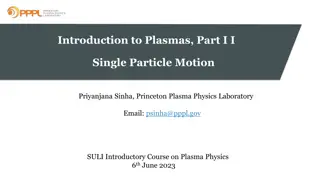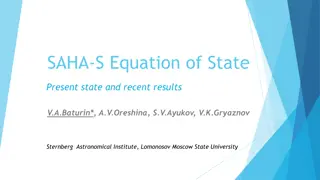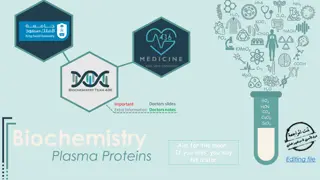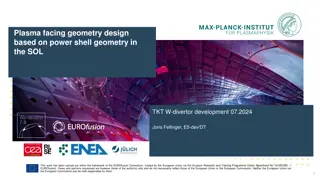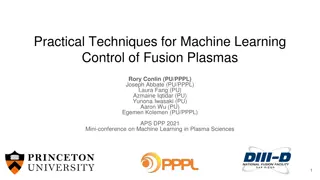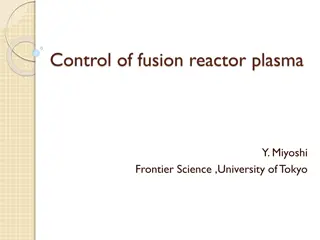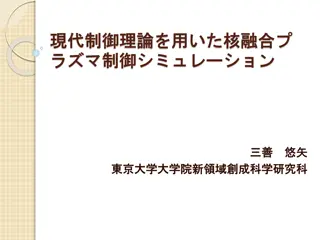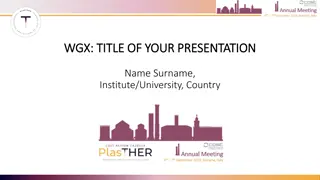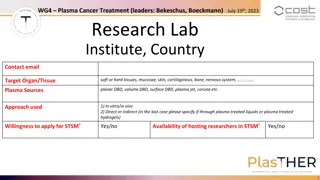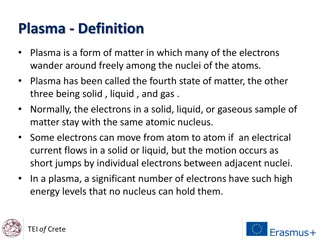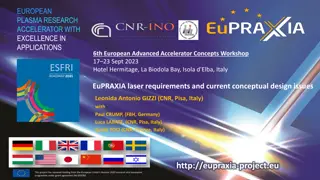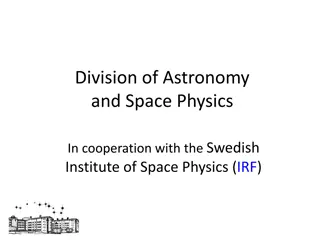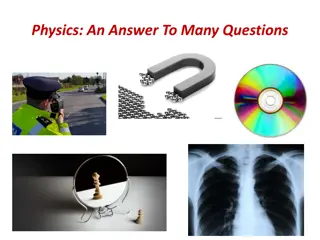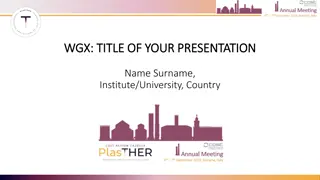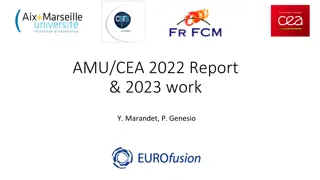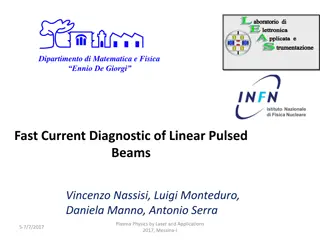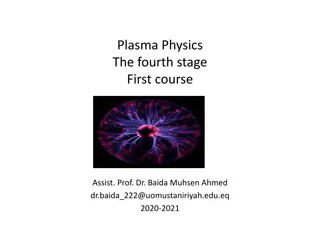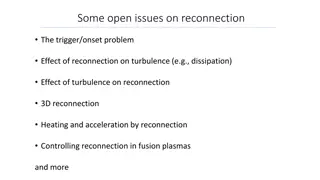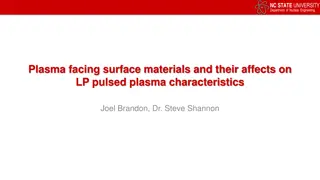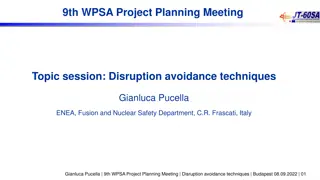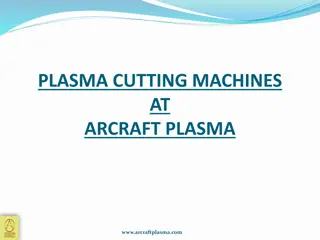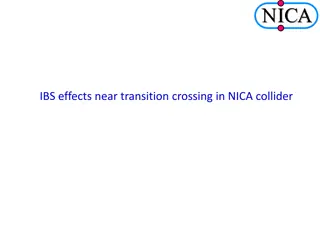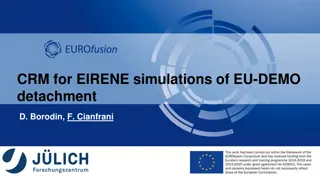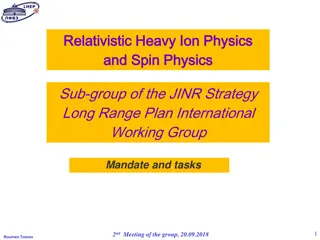Plasma Physics: Single Particle Motion in Magnetic Fields
Delve into the intricate dynamics of single particle motion in plasma physics, focusing on the crucial role of magnetic fields for plasma confinement in fusion environments. Explore concepts such as magnetic mirrors, E.B. drift, and Tokamaks, essential for comprehending the behavior of ions and elec
2 views • 34 slides
Thermodynamics of Solar Plasma: SAHA-S Equation of State and Recent Results
SAHA-S equation of state (EOS) presents the current state and recent results in thermodynamics of solar plasma. Key authors V.K. Gryaznov, A.N. Starostin, and others have contributed to this field over 20 years. The equilibrium composition between 145 species, including elements and all ions, is exp
1 views • 23 slides
Physics Bachelor's Degree Specializations Overview
Explore different specializations within a Physics Bachelor's degree program for the 2021-2022 academic year, including general physics, astronomy, computational physics, materials physics, and optics and lasers. Each specialization offers a unique set of courses and opportunities for students inter
5 views • 9 slides
Enhancing Physics Education: Future Physics Leaders Initiative
The Future Physics Leaders program, a national education project managed by the Institute of Physics, aims to support specialist physics teachers, Newly Qualified Teachers (NQTs), and non-specialist physics teachers in England. By offering professional development, matched timetabling, and mentoring
0 views • 10 slides
Empowering Physics Teachers: Innovations in Professional Development
Discover the latest updates and initiatives in physics teacher training and support programs led by Robin Griffiths and the Institute of Physics (IOP). From stimulating physics networks to nurturing future physics leaders, these projects aim to enhance teaching practices, support disadvantaged stude
7 views • 11 slides
Plasma Proteins in Biochemistry Lectures
This informative content discusses the types, functions, and measurement of plasma proteins in biochemistry. It covers the importance of identifying various plasma proteins, their roles in disease diagnosis, and the interpretation of electrophoretic patterns. The lecture overview provides insights i
0 views • 30 slides
Comprehensive Overview of GES Physics Syllabus Aligned with Khan Academy Resources
Explore the GES Physics syllabus divided into Mechanics, Thermal Physics, Waves, Electricity and Magnetism, Atomic and Nuclear Physics, and Electronics. The syllabus covers a wide range of topics from introductory physics concepts to advanced topics in thermodynamics, optics, electromagnetism, quant
1 views • 5 slides
Mechanism of Low-Energy Nuclear Reactions in Low-Temperature Plasma
This work discusses nuclear-chemical processes underlying low-energy nuclear reactions in low-temperature plasma environments, focusing on the initiation of artificial radioactivity in metal cathodes under protium- and deuterium-containing nonequilibrium plasma conditions. The role of electrons with
4 views • 6 slides
UIL Physics Capital Conference 2019 Topics & Questions Overview
The UIL Physics Capital Conference 2019 featured various physics topics and questions ranging from teaching quantum physics to dogs to fields like astronomy, measurement, uniform motion, forces, energy, and more. The event covered a wide array of physics concepts, and the directed study text focused
1 views • 25 slides
Development of Plasma-Facing Geometry Design for W-Divertor in SOLTKT Fusion Reactor
Study on the plasma-facing geometry design based on power shell geometry in the SOL TKT W-divertor development for the fusion reactor. The research involves fundamental differences in divertor baffle design, materials used, heat load requirements, interface connections, and key design concerns. The
0 views • 14 slides
Master's Programs at University of Strasbourg - Faculty of Physics & Engineering
Explore the Master's programs offered at the Faculty of Physics & Engineering, University of Strasbourg (Unistra) with specializations in Astrophysics, Condensed Matter Physics, Radiation Physics, Subatomic Physics, and Cell Physics. The curriculum includes a strong theoretical background, specializ
2 views • 13 slides
Practical Machine Learning Techniques for Fusion Plasma Control
This presentation discusses the use of machine learning for controlling fusion plasma states, covering topics such as control-oriented modeling, neural networks for plasma dynamics, linearization techniques, and applying linear control laws in latent states for efficient control. The focus is on lev
0 views • 15 slides
Utilizing a Global Model for Analyzing Reaction Pathways in Plasma Systems
This research focuses on using a kinetic global model framework to identify relevant reactions in chemically complex plasma systems. The framework, KGMf, enables the investigation of macroscopic plasma characteristics by analyzing reaction pathways, sensitivity to reaction rate errors, and dominant
2 views • 6 slides
Advances in Fusion Reactor Plasma Control at University of Tokyo
Explore the cutting-edge research on control systems for fusion reactor plasma at the Frontier Science department, University of Tokyo. The study focuses on developing construction and logic control parameters for high-performance plasma, showcasing categorizations of control parameters and actuator
1 views • 25 slides
Advanced Plasma Control Systems in Fusion Experiments
The construction of control systems for high-performance plasma with limited actuators or diagnostics is crucial for ongoing fusion experiments like ITER and DEMO. This involves developing control logic, categorizing various parameters, and understanding actuator systems. Multiple control experiment
2 views • 25 slides
Advancing Plasma Medicine: Research Contributions and Networking Opportunities
Explore the latest in plasma medicine research at the II Annual Meeting. Share your results, network with peers, and contribute to the field through collaborative discussions. Answer key questions, meet deliverables, and pave the way for advancements in plasma therapies and biomedical applications.
0 views • 9 slides
Advancements in Plasma Cancer Treatment: Research Focus and Collaboration Efforts
Explore the cutting-edge research on plasma-based cancer treatment led by Bekeschus and Boeckmann at the Research Lab Institute. The team specializes in addressing cancer in various tissues such as skin, bone, cartilaginous, and nervous systems. Discover their innovative approaches, infrastructure,
0 views • 4 slides
Plasma - The Fourth State of Matter
Plasma, the fourth state of matter, is a unique form where electrons freely move among atomic nuclei. It is created when atoms are ionized and can conduct electricity. This article delves into how plasma is produced, its applications like plasma display panels, and the construction of a plasma displ
0 views • 37 slides
Recommendations for Advancing Beam Physics and Accelerator Education
The exploration of new physics demands future accelerators beyond 1 TeV lepton colliders and 100 TeV hadron colliders, requiring luminosity in a specific range. Various challenges, including reaching quantum limits, face conventional RF-based beams. The pursuit of disruptive acceleration technologie
2 views • 7 slides
European Plasma Research Accelerator with Excellence in Applications
The European Plasma Research Accelerator project, also known as EuPRAXIA, is a cutting-edge initiative that aims to develop a laser driver for advanced accelerator concepts. Led by a team of experts from various European countries, the project focuses on laser requirements, overall layout, thermal m
0 views • 33 slides
Advances in Experimental Particle Physics and Metrology Technologies
This collection of images and text highlights the essential aspects of fundamental physics experiments, particle physics detectors, and the Atlas ITk project. It also focuses on the importance of metrology for physics and satellite experiments, with a specific emphasis on laser technologies. The con
0 views • 11 slides
Plasma Etching Challenges and Solutions in Semiconductor Fabrication
Understanding the importance of plasma etching in semiconductor fabrication, this discourse delves into the challenges faced in modeling modern etch processes. Topics covered include stochastic defect detection, reactor-level plasma physics, and an integrated model hierarchy approach. Techniques suc
0 views • 14 slides
Division of Astronomy and Space Physics Overview: Research and Teaching Programs
Division of Astronomy and Space Physics, in cooperation with the Swedish Institute of Space Physics (IRF), focuses on researching topics such as the first stars and galaxies, re-ionization of the Universe, and more. With distinct but complementary areas of expertise, the division offers programs in
0 views • 10 slides
Physics: An Intriguing Journey Through the World of Science
Delve into the realm of physics, where inquisitive minds seek answers to the mysteries of the universe. Discover the various areas of study, from mechanics to atomic physics, and unravel the intricate course structure. Expect a challenging yet rewarding experience as you delve into the elite world o
0 views • 12 slides
Advancements in Plasma Medicine: Research Contributions and Collaboration Opportunities
Explore how research in plasma medicine contributes to the field, focusing on bioactive components, molecular interactions, standard protocols, and potential biomedical applications. Emphasize the importance of sharing results, fostering collaborations, and addressing critical points for further inv
0 views • 9 slides
Introduction to Particle Physics at U. Wisconsin: Physics 535
Dive into the captivating world of particle physics with Physics 535 at University of Wisconsin. Explore phenomena, delve into Quantum Field Theory and Elementary Particle Physics, and prepare for research work. Engage in in-person lectures supplemented by Zoom for those in isolation. Utilize textbo
0 views • 8 slides
Evolution of Collisionless Plasma Bounded by Absorbing Walls
Study on the evolution of collisionless plasma between absorbing walls, analyzing rarefaction waves, density profiles, and plasma potential decay. Kinetic simulations reveal gas dynamics-like behavior with flat density profiles and linear velocity profiles leading to asymptotic decay. The influence
0 views • 15 slides
Technical Tasks and Contributions in Plasma Physics Research
This collection of reports details the technical tasks undertaken in 2022 by AMU in managing interfaces with ACH for Eiron and IMAS, as well as contributions to EIRENE_unified. It also discusses the parallelization of rate coefficient calculations and the implementation of MPI parallelisation for ef
0 views • 10 slides
Advancements in Plasma Instruments for Space Weather Monitoring
Explore the latest developments in plasma instruments for space weather monitoring, including the PLA Plasma Instrument and MSSL Heritage in Plasma Instruments. These instruments enable precise measurement of plasma parameters in deep space, supporting missions to study solar wind, ion densities, an
0 views • 22 slides
Fast Current Diagnostic Techniques for Linear Pulsed Beams
Explore the advancements in plasma physics and beam diagnostics presented at the Plasma Physics by Laser and Applications conference in Messina. Through detailed talks and images, the evolution of Rogowski coils for linear structures, apparatus calibration, and results are showcased. Discover the ap
0 views • 12 slides
Plasma Physics: The Fourth Stage First Course by Prof. Dr. Baida Muhsen Ahmed
Plasma, the fourth state of matter, was introduced by Langmuir in 1928. It is a unique form of matter containing ions and exhibits collective behavior. This course explores the relationship between solid, liquid, gas, and plasma, discussing forces, parameters, and where plasmas are found in the cosm
0 views • 11 slides
Recent Developments in Plasma Reconnection Experiments
Explore key open issues in plasma reconnection such as trigger/onset problems, turbulence effects, 3D reconnection, and the impact on heating and acceleration. Discover new experimental developments like the Big Red Ball at Wisconsin for field-free plasma confinement and access to different reconnec
0 views • 8 slides
Study on Plasma Facing Surface Materials in Nuclear Engineering at NC State University
This research at NC State University's Department of Nuclear Engineering focuses on the effects of plasma facing surface materials on low-pressure pulsed plasma characteristics. The study delves into topics such as electron sources, secondary emission, dissociative recombination, modeling results, c
0 views • 31 slides
Utilizing Disruption Avoidance Techniques in Plasma Control for Enhanced Stability
Exploring disruption avoidance techniques in plasma control is crucial for maintaining stability and safety in operating scenarios. Gianluca Pucella discusses topics such as plasma disruptions, prevention methods, emergency shutdown protocols, and disruption prediction models involving machine learn
0 views • 7 slides
Advanced Plasma Cutting Machines at Arcraft Plasma
Arcraft Plasma offers high-quality plasma cutting machines capable of cutting ferrous and non-ferrous materials up to 150mm thickness. These machines come in 12 models with beveling and hole piercing options. The plasma cutting process involves the use of air or inert gas to create plasma that melts
0 views • 12 slides
Insights into Intra-Beam Scattering Effects and Plasma Dynamics in Particle Colliders
Intra-Beam Scattering (IBS) effects near transition crossing in NICA collider result in energy exchange between different degrees of freedom, impacting beam size, luminosity, and lifetime. The IBS phenomenon is crucial for circular machines, with theoretical developments by Piwinski and Bjorken shap
0 views • 15 slides
Collisional-Radiative Models for Plasma Detachment Control in Tokamaks
Explore the application of Collisional-Radiative Models (CRM) in EIRENE simulations for plasma detachment control in tokamaks. Learn about detached plasma divertor, main reactions in transport, vibrational states in molecular species, and more through a detailed study of particle species, reaction t
0 views • 10 slides
Relativistic Heavy-Ion and Spin Physics Sub-group Mandate and Tasks
The Relativistic Heavy-Ion and Spin Physics Sub-group, part of the JINR Strategic Long-Range Plan, is tasked with identifying scientific priorities and research infrastructure to maintain JINR's global scientific leadership. Members include experts from various institutions collaborating to develop
0 views • 8 slides
European Plasma Research Accelerator with Excellence in Applications
The European Plasma Research Accelerator project, EuPRAXIA, funded by the European Union's Horizon Europe programme, aims to advance plasma accelerator technology for various applications. With phased construction sites and a focus on laser-driven and beam-driven plasma accelerators, the project env
0 views • 18 slides
Plasma Antenna Technology at College of Engineering, Perumon
The world of plasma antenna technology and its applications at College of Engineering, Perumon. Discover the unique characteristics, working principles, and various types of plasmas used in different scenarios. From artificially produced plasmas to astrophysical plasmas, delve into the fascinating r
0 views • 23 slides
